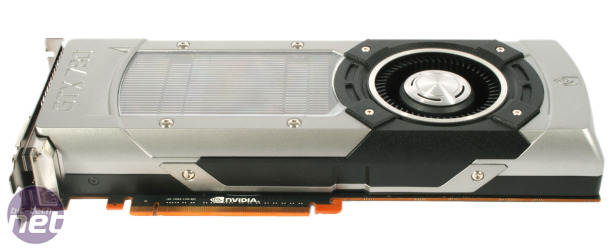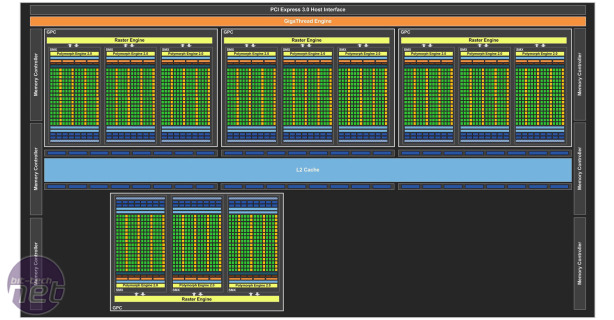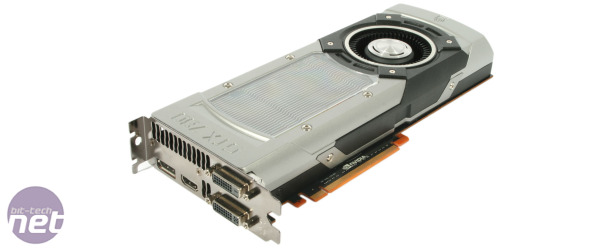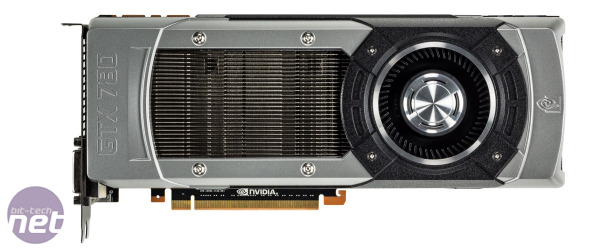
Nvidia GeForce GTX 780 Review
Manufacturer: NvidiaUK Price (as reviewed): MSRP £550 (inc. VAT)
US Price (as reviewed): MSRP $649 (ex. Tax)
We must admit to being a little surprised by the GTX 780 3GB, not least due to its arrival just three months (almost to the day) after the GTX Titan 6GB. Titan was pitched as a range-topping single GPU card in the mould of the 8800 Ultra, albeit at an even higher price tag of around £900, so for the GTX 780 3GB to arrive so soon afterwards, and looking remarkably similar, is rather unexpected.
Click to enlarge - The GTX 780 uses the same gorgeous cooler as GTX Titan
Despite the new 7-series moniker, GTX 780, and indeed any subsequent 7-series cards, do not take advantage of a new GPU architecture or even updates to the silicon in the way that GTX 580 differed from GTX 480 with the addition of low-leakage transistors. Instead, the 7-series is a continuation of the 28nm Kepler architecture we’ve already seen in the 6-series, with Nvidia’s next major architectural update, Maxwell, not due until next year.
Titan-Lite
However, the GTX 780 still raises the stakes in the endless GPU arms-race, with the switch from the GK104 GPU of the GTX 680 2GB to the same GK110 GPU as GTX Titan, albeit a little scaled down. While this doesn’t change the basic SM (streaming multi-processor) design in comparison to GTX 680, there are three SMs per GPC (graphics processor cluster) in GK110, in comparison to two per GPC in GK104/106.Click to enlarge - the GK110 GPU of GTX 780 offers two fewer SMs than GTX Titan, but runs at largely the same frequencies
The GK 110 GPU can also boast up to five GPCs in comparison to GK104’s four, although it’s here that those slightly scaled down specs come into effect. While GTX Titan sports 5 GPCs and 14 SMs (one GPC with 1 SM disabled), GTX 780 has that last GPC entirely disabled, instead boasting four GPCs with a full complement of SMs for a total of 12 SMs. This reduces the stream processor count from 2,688 of Titan to 2,304 for GTX 780; still a large improvement over that of the 1,536 of GTX 680. The loss of the two SMs also reduces the tessellation unit count by two (one per SM), and the texture unit count by 32 (16 per SM). It’s also worth noting that GTX 780’s SMs do NOT boast the double-precision units of GTX Titan, so for compute tasks the Titan remains the only current Nvidia card to offer double precision functionality.
Click to enlarge
Pleasingly, other than the loss of the two SMs, the GTX 780’s GK110 GPU is otherwise intact. This means it retains the 384-bit memory interface and the 48 ROPs of Nvidia’s super-card, although the amount of GDDR5 has been halved from the double-stacked 6GB of Titan to single-stacked 3GB of GDDR5. Running at 1.5GHz (6GHz effective), this means the GTX 780 boasts 288GB/sec of memory bandwidth, matching that of AMD’s Radeon 7970 3GB.
To compensate for the reduced amount of memory and drop in stream processor count, the GTX 780’s GPU actually runs a tad faster than Titan. As we’ve come to expect from Nvidia, it uses GPU Boost 2.0 to increase the GPU clock should thermal and power levels allow. A base clock of 8,36MHz matches Titan, but a guaranteed boost clock of 900MHz is actually a touch quicker. During our testing, we found the stock card would happily boost to 993MHz though, the same speed as the GTX Titan was happy to boost to.
Click to enlarge
Looking at the card itself, it’s clear Nvidia hasn’t deemed it necessary to change of the design in comparison to the GTX Titan; in fact, the GTX 780 basically shares the same 267mm PCB and attractive aluminium stock cooler as Titan, albeit with the branding adjusted to suit. That’s no bad thing as Titan was hailed for its sleek looks and high-quality engineering. The two-part cooler comprises a vapour chamber mounted on top of the GPU, which dissipates heat through an array of cooling fins, and an aluminium shroud which directly cools the power delivery circuitry and memory modules. A radial fan provides the airflow, pulling air in from the end of the card and exhausting it out the rear I/O, while a green-LED lit GeForce GTX logo on the cards top reminds anyone with a case window what make their GPU is.
Click to enlarge -The PCB is the same as GTX Titan too, with an 8-pin and 6-pin PCI-E power connector
It’s comfortably the most covetable stock GPU design we can recall, but seems likely to irk some of Nvidia’s GPU partners; we highly doubt we’ll see the same array of third-party coolers as usual and other than the radial fan’s motor there’s little-to-no space to put branding stickers. With the huge variability in after-market coolers though, we’re pretty happy Nvidia has started to invest in its stock models to such a degree, a trend that looks set to continue into the rest of the 7-series. All that said, though, as we found in our recent look at after-market graphics card coolers, there is often head room for reducing operating temperatures and noise levels, so we'll be interested to see if any partners do attempt some more exotic solutions.
With a similar GK110 GPU and the same PCB and cooler as GTX Titan, it’s not surprising to find that GTX 780 matches it with power requirements. A TDP of 250W is 55W higher than that of GTX 680, but with the significantly uprated cooling it’s unlikely to cause problems.
So, GTX 780 is in truth, a slightly neutered GTX Titan, but considering Titan’s monster performance, this still makes GTX 780 a formidable card on paper. So formidable in fact that, rather than price it the same as the out-going GTX 680 (which launched at £429), Nvidia is going up another pricing rung, with the GTX 780 set to go on sale for £550. This, presumably, will result in the whole GeForce range shifting up a notch for 7-series, which, considering the reducing relevance of it’s low-end in the face of improving processor graphics, does make some sense. Nonetheless, we’re still not fans of dropping more than half a grand on a top-end single-GPU card, although there’s certainly precedent; the 8800 Ultra launched at a similar price back in 2007.
GTX 780 Specs
| Nvidia GeForce GTX 780 3GB | Nvidia GeForce GTX Titan 6GB | Nvidia GeForce GTX 690 4GB | Nvidia GeForce GTX 680 2GB | Nvidia GeForce GTX 670 2GB | Nvidia GeForce GTX 660 Ti 2GB | |
| GPU | ||||||
| Codename | GK110 | GK110 | 2 x GK104 | GK104 | GK104 | GK104 |
| Base Clock | 836MHz | 836MHz | 915MHz | 1,006MHz | 915MHz | 915MHz |
| Boost Clock | 900MHz | 876MHz | 1,019MHz | 1,058MHz | 980MHz | 980MHz |
| Stream Processors | 2,304 | 2,688 | 2 x 1,536 | 1536 | 1344 | 1344 |
| Layout | 12 SMs, 4 GPCs | 14 SMs, 5 GPCs | 2 x 8 SMs, 4 GPCs | 8 SMs, 4 GPCs | 7 SMs, 4 GPCs | 7 SMs, 4 GPCs |
| Rasterisers | 4 | 5 | 2 x 4 | 4 | 4 | 4 |
| Tesselation Units | 12 | 14 | 2 x 8 | 8 | 7 | 7 |
| Texture Units | 194 | 224 | 2 x 128 | 128 | 112 | 112 |
| ROPs | 48 | 48 | 2 x 32 | 32 | 32 | 24 |
| Transistors | 7.1 Billion | 7.1 Billion | 2 x 3.54 Billion | 3.54 Billion | 3.54 Billion | 3.54 Billion |
| Die Size | 551mm² | 551mm² | 2 x 294mm² | 294mm² | 294mm² | 294mm² |
| Process | 28nm | 28nm | 28nm | 28nm | 28nm | 28nm |
| Memory | ||||||
| Amount | 3GB GDDR5 | 6GB GDDR5 | 2 x 2GB GDDR5 | 2GB GDDR5 | 2GB GDDR5 | 2GB GDDR5 |
| Frequency | 1.5GHz (6GHz effective) | 1.5GHz (6GHz effective) | 1.5GHz (6GHz effective) | 1.5GHz (6GHz effective) | 1.5GHz (6GHz effective) | 1.5GHz (6GHz effective) |
| Interface | 384-bit | 384-bit | 2 x 256-bit | 256-bit | 256-bit | 192-bit |
| Bandwidth | 288GB/sec | 288GB/sec | 2 x 192GB/sec | 192 GB/sec | 192 GB/sec | 144 GB/sec |
| Card Specifications | ||||||
| Power Connectors | 1 x 6-pin and 1 x 8-pin PCI-E | 1 x 6-pin and 1 x 8-pin PCI-E | 2 x 8-pin PCI-E | 2 x 6-pin PCI-E | 2 x 6-pin PCI-E | 2 x 6-pin PCI-E |
| Stock Card Length | 267mm | 267mm | 279mm | 257mm | 240mm | 240mm |
| TDP | 250W | 250W | 300W | 195W | 170W | 150W |
| Typical Street Price | £550 | £825 | £815 | £370 | £290 | £220 |

MSI MPG Velox 100R Chassis Review
October 14 2021 | 15:04













Want to comment? Please log in.